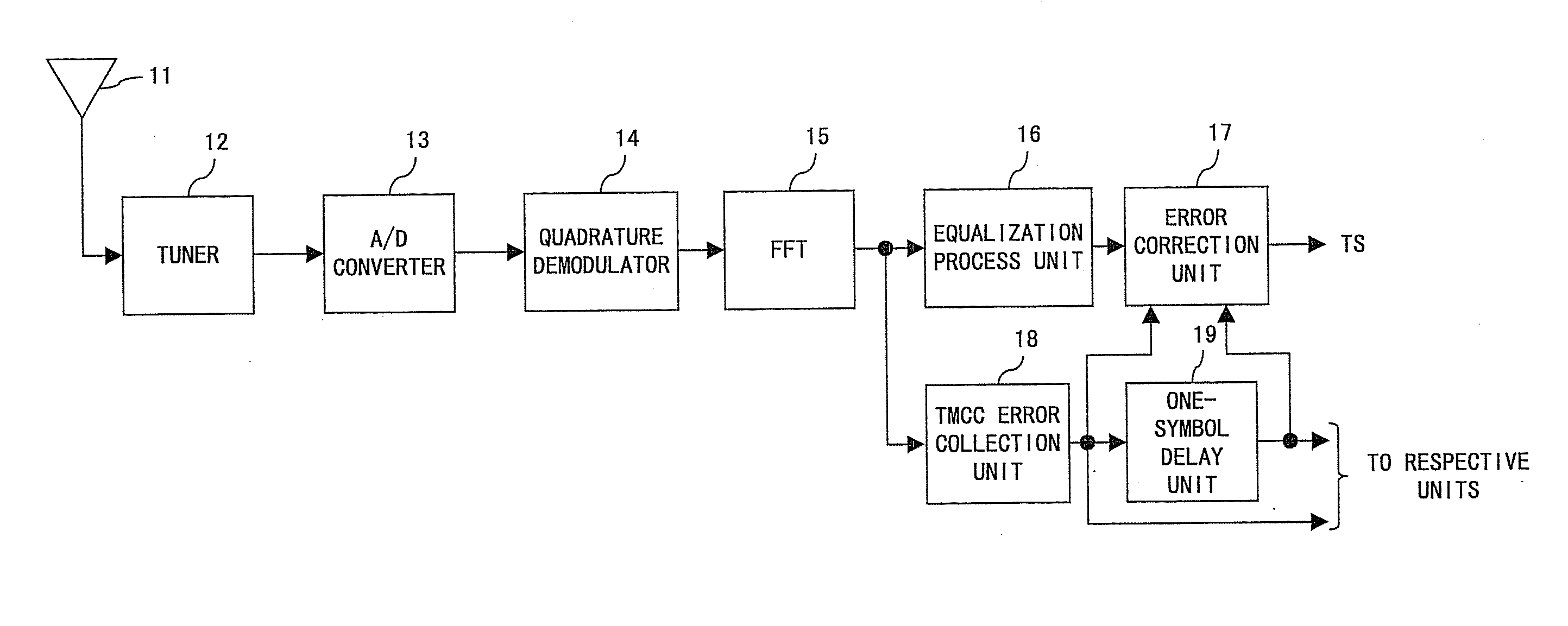Device and method for receiving digital signal transmitted using OFDM method
a digital signal and ofdm technology, applied in the field of receiving digital signals, to achieve the effect of reducing memory capacity and improving reception performan
- Summary
- Abstract
- Description
- Claims
- Application Information
AI Technical Summary
Benefits of technology
Problems solved by technology
Method used
Image
Examples
first embodiment
[0067]Therefore, in the first embodiment, which is explained hereinbelow, the data accuracy when the demapping process 21 in FIG. 5 receives the demodulated data output from the equalization process unit 106 is twelve bits per symbol; further, in the determination processes 20-1 and 20-2, the number of bits in a soft decision (a decision in which information in accordance with the distance between a received signal and a reference point on the constellation of a modulated signal is added and that is made in order to improve the gain in the viterbi demodulation process 25) made when a demapping process is executed in the demapping process 21 is always three regardless of the contents of the TMCC information. By this configuration, even when the 16 QAM, whose information amount per symbol is the largest among carrier modulation methods employed in 1-segment broadcasting or 3-segment broadcasting, is employed, the memory capacity required for the deinterleaving processes executed in la...
second embodiment
[0076]In the present invention, in the 3-segment broadcasting shown in FIGS. 6C and 6D, when the “size” exceeds 16, i.e., when the 16 QAM is used as the carrier modulation method in hierarchy B among sub carriers and also the time interleave parameter is the largest possible value in the corresponding transmission mode (I=4 in “MODE2”, and I=8 in “MODE3”), the “number of bits” as the transmission parameter is two. In these figures, the “size” value in the transmission parameter in which the “number of bits” is “2” is the value when the soft decision is made with three bits.
[0077]Thereby, it is possible to reduce the memory size required for the deinterleaving processes by two-thirds. In other words, in FIGS. 6C and 6D, the soft decision regarding the transmission parameter in which the “size” is “24”, for example, is made with two bits; thereby, the “size” is 16. As a result, although the performance in this transmission mode becomes insufficient, the ⅓-segment receiver can be reali...
PUM
 Login to View More
Login to View More Abstract
Description
Claims
Application Information
 Login to View More
Login to View More - R&D
- Intellectual Property
- Life Sciences
- Materials
- Tech Scout
- Unparalleled Data Quality
- Higher Quality Content
- 60% Fewer Hallucinations
Browse by: Latest US Patents, China's latest patents, Technical Efficacy Thesaurus, Application Domain, Technology Topic, Popular Technical Reports.
© 2025 PatSnap. All rights reserved.Legal|Privacy policy|Modern Slavery Act Transparency Statement|Sitemap|About US| Contact US: help@patsnap.com



